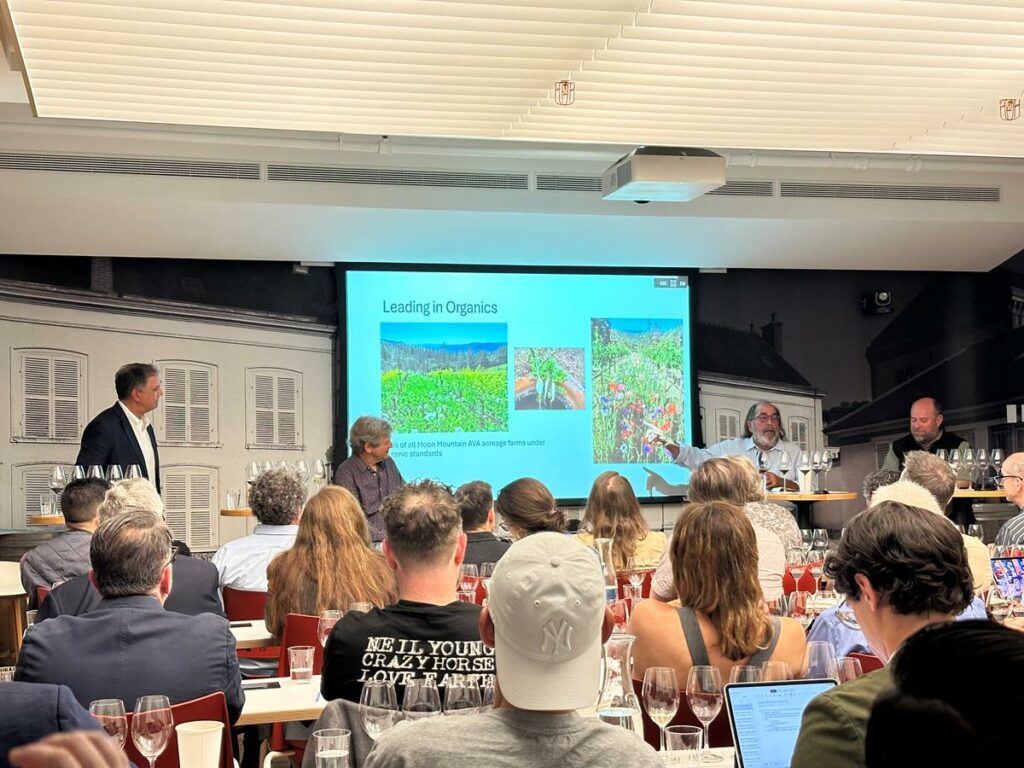A quick note about a dynamic and special moment for the Moon Mountain District that we recently hosted in our offices in New York. We offered our space to the Moon Mountain Grower’s Association so that they could, for the first time ever, hold a press and top trade event in New York City. Five leading Moon Mountain District producers – including Rodrigo Soto of Far Mountain – presented a seminar on the appellation, followed by a walkaround tasting of over 10 producers’ top wines.
You could feel the electricity as all the things that make the appellation special came forward. Moon Mountain is truly one of the few terroir-defined appellations in the United States, defined geographically by its elevation, climate and geology, rather than county lines, major roads and more generic factors. You’ll see below some photos and notes from the event. You can watch and listen to the full seminar HERE
This event was a collaboration within the best producers of the region with the single purpose of presenting in depth the quality attributes of the appellation. The presentation was kicked off with Robert Kamen, a seminal figure in the appellation’s development. His journey with Moon Mountain began almost by accident: after selling his first movie script (he wrote The Karate Kid, The Fifth Element, Taps, and other well known films) he purchased 300 acres of unpaved land in Sonoma County. His chance encounter with legendary local grower Phil Coturri (also on the panel) led to a realization that the site’s unique high-elevation soils and climate could support fruit so distinctive it commanded multiples the usual price. At a time when Sonoma winemakers seldom discussed terroir, Kamen and Coturri championed these rocky slopes, laying the groundwork for an appellation defined by elevation, geology and microclimate.
You should really listen to the hilarious and compelling stories from Robert Kamen at the start of the seminar in the link above.

In 2013, a formal petition was presented to the government entities and Moon Mountain became the first Sonoma AVA to base its boundaries on quality factors—elevation (400 to 2,200 ft), specific volcanic geology, and a distinct mountain climate. Of the AVA’s 17,000 acres, less than 8% are planted, echoing the sparsely inspiration of Monte Rosso (first planted in 1880), the Moon Mountain vineyard that is one of California’s most famous (look out next year for Far Mountain’s first Monte Rosso release). The deep red soils, fractured bedrock and abundant creeks (over 63 miles of them, plus a 6,000-acre wildlife corridor) foster clean sources of water and rich biodiversity. Nearly half the vineyards are farmed organically or regeneratively, with active soils that breathe from below, nurturing deep roots and distinctive minerality. Although primarily known for Cabernet, the high-elevation pockets also produce elegant Chardonnay and even Pinot Noir.
Winemaking on Moon Mountain resembles harmony with nature and expression of site. Phil Coturri’s veteran mountain-growing techniques were echoed by all producers at the tasting emphasizing the importance of organic farming for quality purposes. The tasting started with the softly spiced, exotic-finish 2022 Hanzell Chardonnay continuing with the polished and well balanced 2022 Sojourn Monte Rosso Cabernet Sauvignon. Later a few of the more rugged offerings showed immense complexity: the hand-crafted 2022 Far Mountain Montecillo (to be released later this year) you could see tannins revealing the mountain’s signature and character; the 2021 Kamen Lava block had rich, ripe layers derived from southwest slopes; and the 2013 Repris Cabernet Franc exemplified how age releases leather and acidity while retaining plush complexity.
The event illustrated that great appellations in the world have been created in places with history, great climate and soils together with visionary people that work collectively. All those elements are aligned for The Moon Mountain District. To a great collaboration and to many more in the future.
